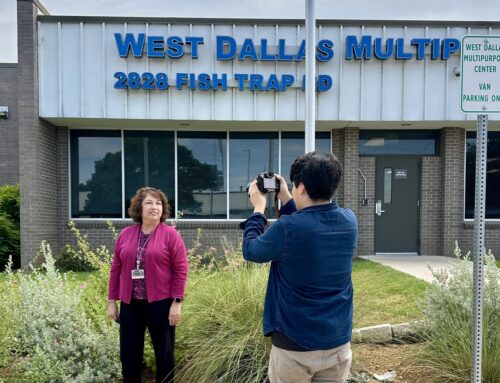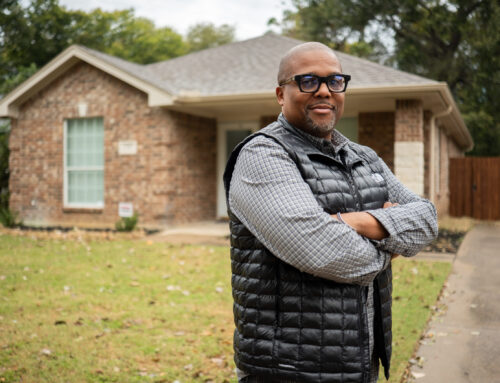How a cooking class paired with a free bag of ingredients creates a recipe for healthy food access

The teaching kitchen inside the West Dallas Multipurpose Center is lively on a Monday evening. Chicken and daikon radishes simmer in curry, and people chat amiably before they’re interrupted by the voice of Liz Espie, a Texas A&M AgriLife Institute volunteer.
“It’s smelling yummy, right?” Espie says.
All 25 attendees are gathered for Local Kitchen, a weekly eight-part course that teaches them how to prepare nutritious recipes. It’s more than just a cooking class — it’s a City of Dallas initiative aimed at transforming the way communities access and think about food in a neighborhood long defined as a “food desert.”
In neighborhoods like West Dallas, where grocery stores are scarce, public health advocates grapple with how to make sure residents have access to nutritious food. This usually shows up in one of two ways: Either providing free or low-cost produce in convenient formats, such as Brother Bill’s Helping Hand free grocery store or Ledbetter Eagle Ford’s community food pantry; or teaching residents how to implement healthy practices, such as the Health through Agriculture series the multipurpose center offers to promote adding vegetables and fruit to residents’ daily intake.
What’s unique about Local Kitchen is that it aims to do both — give a man a fish and teach him to fish simultaneously.
The course is free, and after each session, participants receive a bag with all of the ingredients, spices and oils used so they can recreate the recipe they observed at home — no need to find daikon radishes or the spices for curry at their grocery store.
“If you only have $20 to feed your family and you know they like ramen, you’re going to buy ramen,” says Ashley Hutto, manager of the City’s West Dallas Multipurpose Center. “You’re not going to buy lentils you don’t know how to cook, or you’re not sure your kid is going to eat.”
Step 1: How should vegetables grow, look and taste?
Vegetables are center stage during each Local Kitchen session.
The class starts with Claire Howell leading participants to the multipurpose center’s garden, a space that has been transformed into a small-scale example of what urban agriculture can look like.
Howell is the founder of Balcony Box, which focuses on making homegrown food more accessible, especially in urban environments where traditional gardening space is limited. For Howell, collaborating with Local Kitchen is a natural fit as she already leads the center’s Health Through Agriculture series.
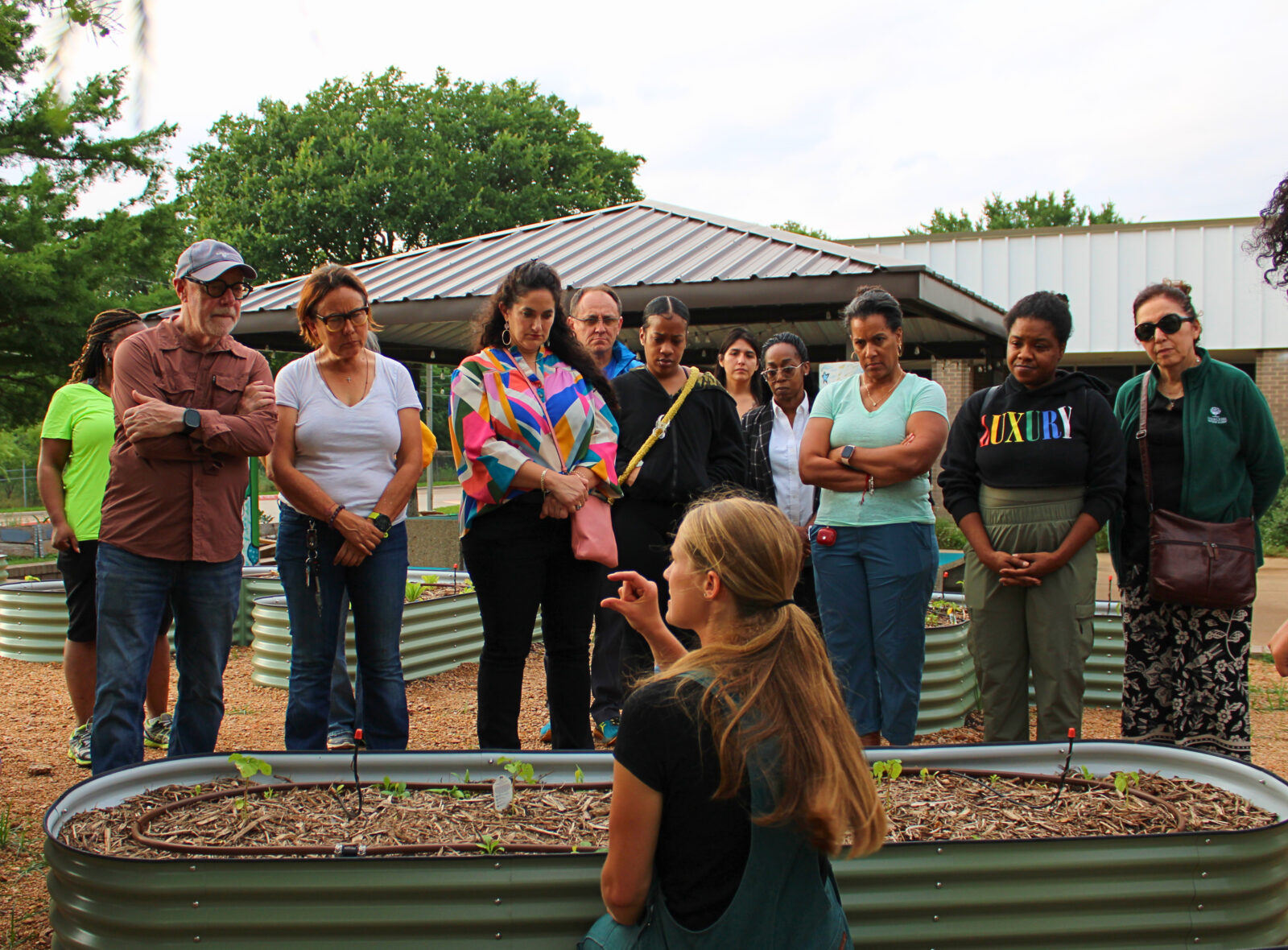
“My main goal is to increase the familiarity around what local produce looks like,” Howell says. “In turn, I’m hoping to equip people with the knowledge to grow their own produce at home and know what the expectations are for the environment plants need to grow, how they look, and how they taste.”
Howell walks the participants through the rows of planter boxes, stopping to identify each vegetable and herb. She explains how each plant looks at different stages of growth and offers practical tips for planting at home, even in containers or small yards.
She also breaks down the nutritional profile of each crop, such as kale’s high vitamin K content for bone health, chamomile’s calming properties and mustard greens’ antioxidant benefits. During Monday’s class, attendees roll up their sleeves, grab their harvesting shears, and collect handfuls of fresh kale, mustard greens and chamomile as Howell instructs them about soil types, watering techniques and how weather conditions affect plant growth.
Step 2: Become acquainted with unfamiliar vegetables
When participants return to the teaching kitchen, they proudly compare their harvest and share stories from their garden experience.
The hands-on encounter brought the lessons to life, showing participants that sustainable gardening can be both approachable and rewarding, Howell says.
“I didn’t know anything about daikon radishes, and I’m usually picky about what I eat,” says Ashley Savage, who commutes about 30 minutes from Arlington to participate in the program. “But coming here, I learned how to cook with vegetables I’d never buy at the store and actually make them taste good. I also learned how I can grow real food in my garden, not just flowers.”
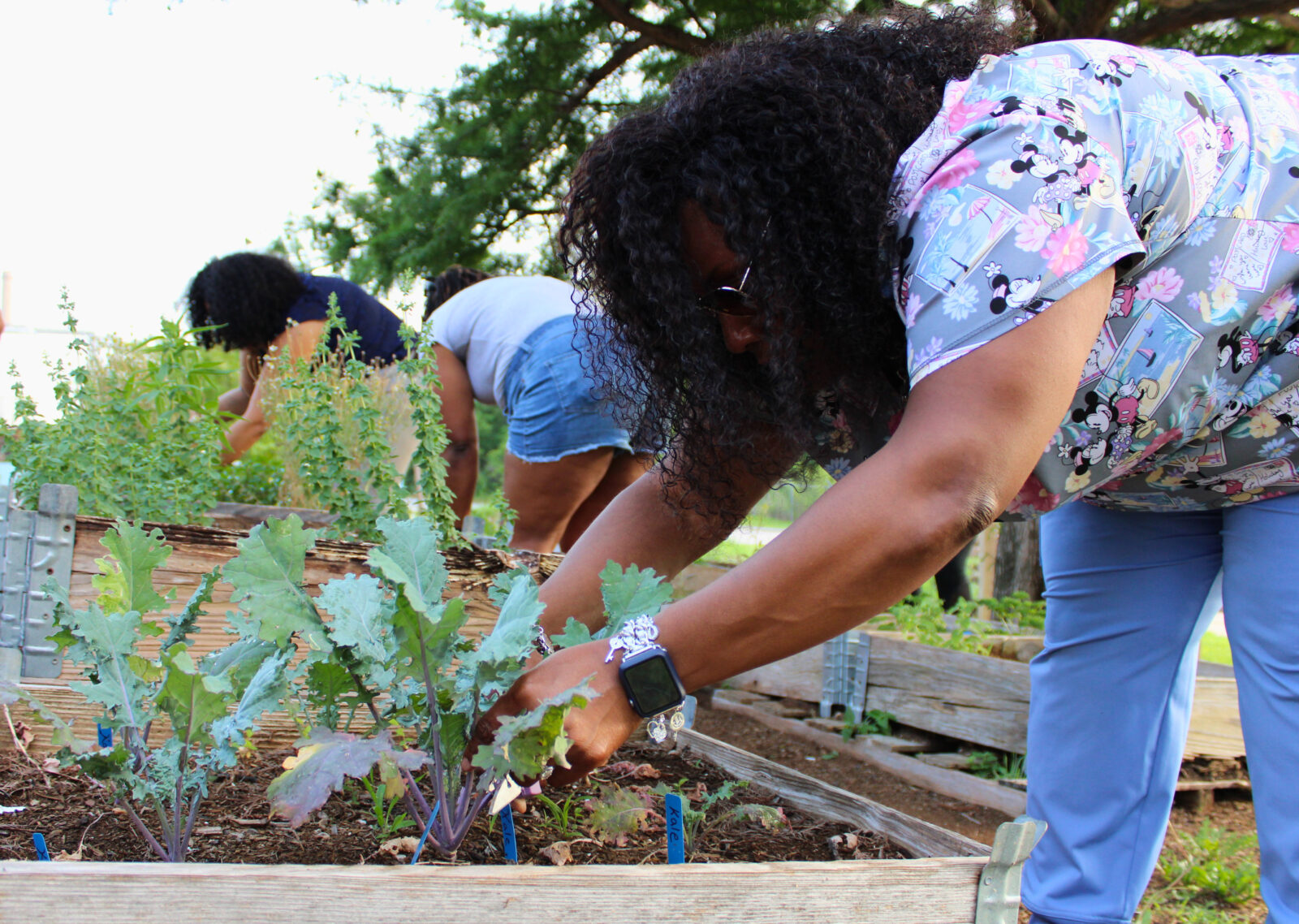
In Monday’s class, Espie places the daikon radishes and other featured vegetables — microgreens and beech mushrooms — at the center of an island. She asks the participants to take a moment to consider which produce items they recognize and which may be unfamiliar.
One woman’s finger points toward the daikon radishes, a white root vegetable. “Have you ever cooked with this?” she asks her fellow classmates. Only a couple have. More of them recognize the microgreens and beech mushrooms.
At the end of each class, participants sample the dish and ask questions about substitutes if there are flavors or vegetables they’re not a fan of.
“If someone in our household doesn’t like mushrooms, is it OK if we leave those out? Or is it going to change the flavor a lot if we take it out?” asks Angela Randall, a South Dallas participant.
Step 3: Instructions and ingredients to do it yourself
As they head home, attendees are given a recipe booklet, which includes a gardening guide for each vegetable, along with their bag of free ingredients. This week’s bag includes three to four pieces of whole ginger, green onions and pre-portioned amounts of curry, garlic powder, cornstarch, canola oil and kosher salt, plus the chicken and fresh vegetables.
Most of the weekly produce comes from Hardie’s Fresh Foods, a distributor that sources from Texas farms and growers. The seasonal produce can be among the more expensive items in the recipe, and the multipurpose center’s garden can’t supply it.
“One of the things we are never going to have is the space to be a production garden,” says Hutto, noting that it’s more of a “demonstration garden” that helps people learn how and when to plant.
Even the garden’s limited produce isn’t always appealing to people who visit the center to pick up free food, she says. For example, just-picked eggplant, okra and greens often are passed over by families unsure of what to do with them.
Hutto previously oversaw the Healthy Cities program at the Baylor Scott & White Health and Wellness Center in South Dallas’ Juanita J. Craft Recreation Center. Participants in the 10-week program met once a week, with the first six weeks focused on chronic health conditions and self-management. The final four weeks featured a cooking and nutrition course, where participants prepared a weekly dish related to managing those conditions.
The lightbulb for Hutto was what happened when they sent the recipe ingredients home.
“We saw incredible adoption rates because they weren’t having to risk their dollars on foods that they weren’t confident their family would eat,” Hutto says.
“If I can remove the risk by giving people produce they might not normally choose — and showing them how to use it — they’re more likely to try new recipes they’d otherwise avoid because of limited resources,” Hutto says.
Why the City of Dallas invests in this cooking class
Local Kitchen is the multipurpose center’s newest initiative to address food insecurity and food-related health issues in West Dallas, but it’s far from the only one. Hutto even co-hosted a food access fair last fall to connect neighborhood service providers working on food access to neighbors looking for food, and to “help jumpstart the conversation around what we need in our community and who can do what,” she says.
“My goal at the center is to implement services and programs so that people aren’t food dependent on the center,” Hutto says.
For the food access fair, she partnered with West Dallas Environmental Commissioner Esther Villareal. All Dallas communities having access to healthy local foods is an explicit goal of the City’s climate action plan, and corresponding urban agriculture plan.
This is why Dallas’ Office of Environmental Quality & Sustainability committed an initial $15,000 to launch the Local Kitchen. Rabekha Siebert, an environmental coordinator with the City of Dallas, says the West Dallas Multipurpose Center “was the perfect place to pilot the program because it recently underwent soil testing and is greenlit to grow produce.”
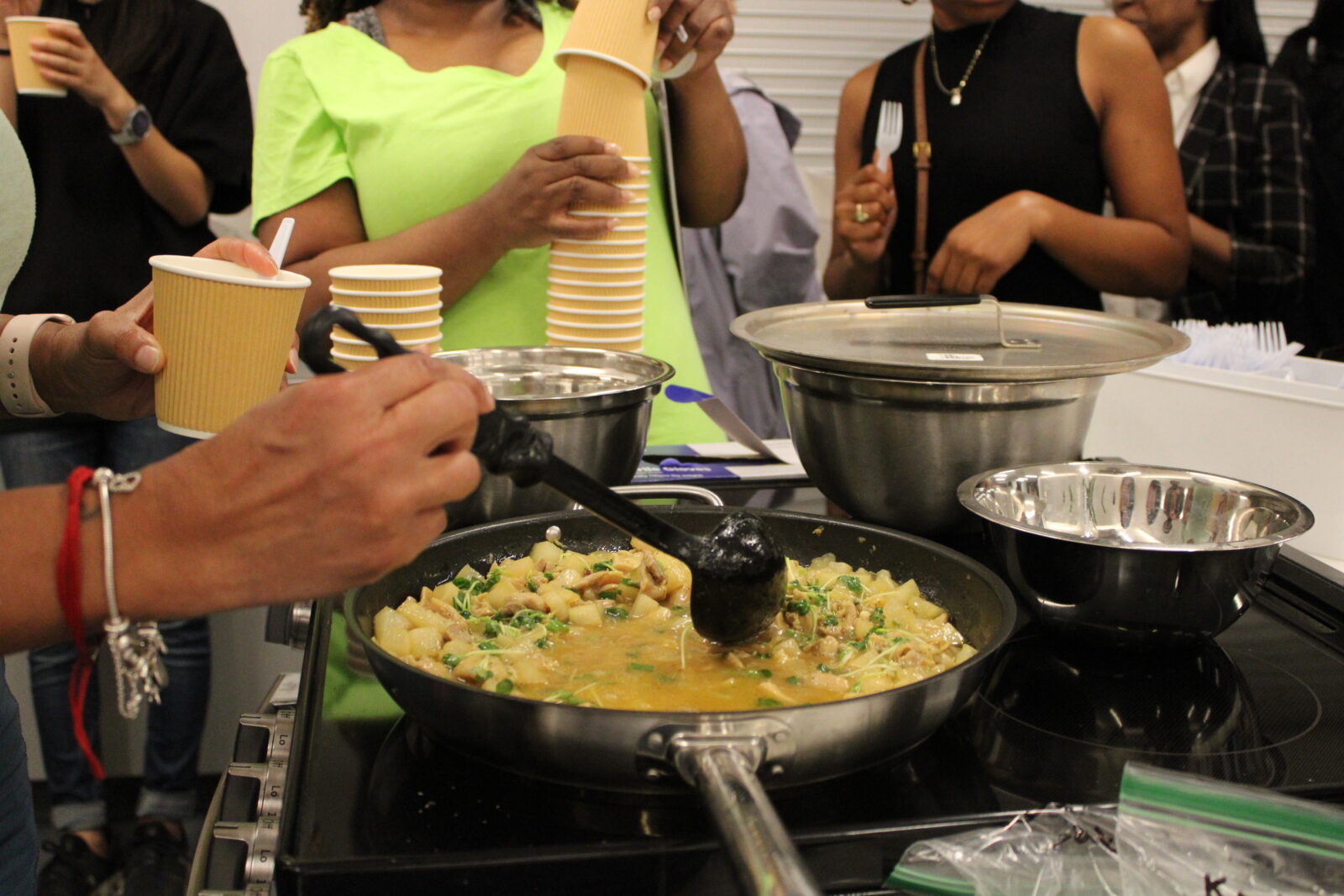
The center and its garden are surrounded by industrial plants allowed by the City’s zoning, including its next door neighbor, a GAF asphalt shingles plant, which residents are fighting to remove. West Dallas’ history of environmental injustice is connected to its lack of grocery stores and residents’ hesitation to eat from their home gardens.
“Not only did they have multiple of these beautiful raised beds,” Siebert says of the center, “they also had a big enough teaching kitchen for us to work with.”
It’s hard to find both at the same site, she says, and it’s also difficult to find local farms and gardens that can supply large quantities of the seasonal produce featured in each recipe.
Because the center is part of Dallas’ Office of Community Care and Empowerment, the class also was an opportunity to encourage consumption of fresh produce cultivated on City-owned soil, Siebert says. This fulfills urban agriculture plan goals to support sustainable land use and increase the demand for locally grown produce.
The Local Kitchen class was so popular that more than 100 people applied, but because of the size of the center’s teaching kitchen, Siebert says, they were able to accommodate only 30 participants.
“We wanted as many people involved as possible,” she says.
The City intends to host the class again so that residents begin to see food as something they can produce, not just purchase. For many, it’s the first time they see what a leafy green looks like before it ends up in a grocery store bin, Siebert says.
Texas A&M Agrilife will evaluate the pilot program through the lens of health. Evaluators will find out whether participants ate more vegetables, adopted new habits in their planting, growing, cooking and seasonal eating, or began purchasing more locally-grown, nutrient-rich produce. These factors are key to the program’s long-term impact and scalability, Siebert says.
Share This Story, Choose Your Platform!
Brenda Hernandez-Rodriguez is Dallas Free Press’ 2024-25 Report for America corps member. A bilingual journalist who is passionate about the field, Hernandez says, “I know it has the power to change lives, even sometimes to save lives. Brenda graduated from St. Edward’s University with five internship experiences that prepared her to be a reporter who makes a difference.
When Hernandez is not writing, she enjoys spending time with her dogs, whether watching movies together or walking. Hernandez also proudly calls herself an adventurous foodie and has become a go-to source of advice about where to eat next in her hometown of Austin, Texas.
Areas of Expertise:
Community journalism
Civic reporting
Location Expertise:
Dallas, TX
Official Title:
Report for America Corps Member
Phone Number:
+1 (512) 739-8153
Email Address:
brenda@dallasfreepress.com


